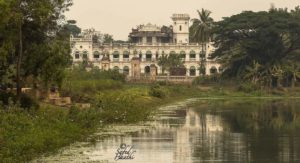By: Rusiraj Pattanayak
Sometime about 1200 AD, a brother of the then Chief of Mayurbhanj, by name Bhujabal Bhanja, acquired by conquest a small territory in what is now known as Kanika. The place was then ruled by a Raja Bhujabal Bhanja, having subdued the Raja, set up a Government of his own & thus founded the Bhanja Raj of this Fort, the status of which was recognized by the Vishnuvite or Gajapati (Gangetic) dynasty of Odisha in the middle of the thirteenth century of the Christian era.
The Fort originally consisted of what is now known as Elaka Chhamuka, to which the portion lying in the District of Balasore and called Panchmukha was soon added. Elaka Kerara was sometime after acquired, probably by conquest, the date of which cannot now be as certained. The last Elaka Kaladwip, which until the close of the eighteenth century formed part of a separate Raj known as Hari-chandan, was acquired by matrimonial alliance with its last Raja, whose daughter was married to Raja Balabhadra Bhanja of Kanika.
The Fort/Quilla is situated along the sea coast on both sides of the estuary of Dhamra, extending about 20miles inland & contains an area of 440 square miles. The seat of the Raj was originally at a place called Bajarpur, on the right bank of the Baitarani River and was after-wards removed to Righagarh, on the right bank of the Brahmani River.The latter place having proved unhealthy, it has since been removed to Rajkanika, which is situated directly on the Cuttack Chandbali road, about four miles to the south of the Chandbali Port.

The heraldic emblem of the family is the figure of a peacock, from which is derived the name of the Richest Feudatory State of Mayurbhanj, a brother of the Chief of which State, as mentioned above, founded the Bhanja Raj family in Kanika. The family has its origin in the Surya dynasty, being a branch of the Raj family of Jaipur in Rajputana.
The following is the succession list of the Chiefs of the dynasty since its foundation down to the British occupation of the Province in 1803:
(1) Bhujabal Bhanja
(2) Bishwanath Bhanja
(3) Trilochan Bhanja
(4) Gopinath Bhanja
(5) Paramananda Bhanja
(6) Dibya-sinha Bhanja
(7) Narasinha Bhanja
(8) Tribikram Bhanja
(9) Gangadhar Bhanja
(10) Gopal Bhanja,
(11) Basudeb Bhanja
(12) Raghunath Bhanja
(13) Lakshman Bhanja
(14) Bairagi Bhanja
(15) Trilochan Bhanja II
(16) Gopinath Bhanja II
(17) Paramananda Bhanja II
(18) Sarbasinha Bhanja
(19) Basudeb Bhanja II
(20) Divyasinha Bhanja II
(21) Narasinha Bhanja II
(22) Tribikram Bhanja II
(23) Gadadhar Bhanja
(24) Gopinath Bhanja III
(25) Dasarathi Bhanja
(26) Gopal Bhanja II
(27) Bairagi Bhanja II
(28) Balabhadra Bhanja.

Image Courtesy: Silpa Priyadarshini
The status of the Chiefs of the Kanika Gada a down to 1803 was more or less that of a semi-independent ruler of a small principality. They were in possession of full sovereign right within the territory and their allegiance to the Kings of Orissa, and subsequently to the Mahommedan and the Mahratta rulers of the Province, was only nominal.
Image: eOdisha.org